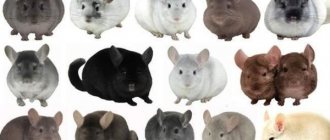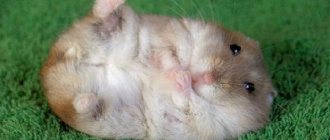Appearance
Dumbo differs from an ordinary rat in his ears - they are low-set and quite large. Moreover, the larger the ears, the more valuable the representative of the breed.
There are two types of auricles:
- The saucer shape is flat and round.
- Bud shape - they have sharp tips and are slightly curled inward, which is why they resemble small flower buds.
Reference! Dumbo with bud-shaped ears are very popular in European countries.
How to determine gender
The sex of adults can be determined quite easily. To do this, you just need to carefully study the structure of their genitals.
Things are more complicated with baby rats. Their gender can be determined with certainty only a few days after birth.
To determine the gender of a small rodent, you need to pay attention to its tummy, which is still completely devoid of fur. If we can see two rows of nipples, which during this period resemble small pimples, we have a girl; if not, we have a boy.
If you want to keep several rats, but are not going to breed them, choose girls. It will be easier for females to get along together than for males, who will periodically engage in fights for leadership, territory and food.
Main characteristics
Dumbo differs from its relatives in the following parameters:
- Body. The body is shorter and stockier. The size of an adult varies from 16 to 21 cm, weight - from 240 to 410 grams. Males are noticeably larger than females.
- Head. Round, muzzle elongated and sharp.
- Wool. Color and structure are variable.
- Tail. By standard, the tail is long and quite thick. There are also tailless varieties.
What is the reason for the abundance of colors?
Siberian huskies were bred by the Chukchi tribes on the basis of aboriginal dogs - close relatives of wolves. They transported light loads over long distances.
They bred hardy pets that were not afraid of frost and easily tolerated hunger. The emphasis was on working qualities, and appearance was not given importance.
Today the working breed has been “retrained” as a companion. The trend has developed due to the spectacular appearance of dogs: a fluffy coat, a fox tail, erect ears and an expressive face.
Because of their working background, Huskies come in so many colors.
According to the Fédération Cynologique Internationale (FCI) standard No. 270, any color is allowed - from white to black, in any combination of colors, with or without various markings on the head.
Genetics are amazing: future coloring depends on one pigment - eumelanin. It gives the coat a black or brown color. And the combination of color-forming genes determines what color the puppy will be born.
Foreign breeders distinguish about 20 colors of Siberian Huskies. Domestic ones are more conservative and consider only white and its combinations with gray, brown and black to be correct.
But the rest of the husky colors are not a defect. Dogs of this breed are born as diverse as snowflakes.
Animal character
Breeders identify three temperaments characteristic of Dumbo:
- Learning ability. With regular training, the rodent quickly becomes tamed and learns to perform simple tricks.
- Laziness. This point follows from the first - the rat quickly understands the cause-and-effect relationship “following the command - a treat” and becomes lazy if it sees that there will be no reward.
- Friendliness. Dumbo loves to spend time with his owner. They take the initiative to get to know other household members. However, if the owner spends a lot of time outside the home, the pet may get bored. Therefore, veterinarians advise having two same-sex individuals at once.
Taming
When the animal gets comfortable in the cage and gets used to the new environment and smells, you can begin taming it. Consistency and regularity are important here. It is necessary to approach the cage several times every day and offer the rat a treat through the bars. When the animal comes up to take it, you need to call it by name.
At the next stage of training, they do the same thing, but with the door open. The rat should come and take the treat. Soon she will become so bold that she will sit on her palm. You don't need to pick her up right away. The rat should be able to return to the cage whenever it wants because it feels safe there.
It won't be long before the pet wants to get to know its owner better. Dumbo rats usually climb up the sleeves of clothing and sniff. This is how they study the smell of their owner. When this moment comes, the main thing is not to scare the animal. The rat must understand that nothing threatens it outside the cage.
Important! Irregularity is the main enemy of training. Tactile contact is just as important for your pet as good care. You need to make it a rule to pick up a rat every day and play with it, otherwise it will go wild.
With good care, a decorative pet rat will live about 4 years, provided that it does not have genetic diseases. Her health depends entirely on her maintenance and nutrition.
What do you name the rat Dumbo?
Look at your new eared pet, think about what you could call him? Perhaps his character and appearance remind you of some character from a fairy tale, book or cartoon? If you find it difficult to choose, then use our lists!
| Names for boy rats: | Names for girls: |
|
|
You can find out more about names in the article - What to name a pet rat?
Choosing a name for Dumbo the rat?
The owners are trying to give the young, smart baby Dumbo a deep and meaningful nickname in the hope that the animal's name can influence the character and intelligence of the funny animal. Sometimes it can be difficult to immediately name a pet with a suitable name that emphasizes its individuality and expresses the love of its owner.
It is advisable to take a few days to take a closer look at the habits and character traits of the new family member; most likely, he himself will tell the owner what to call him. The furry baby's nickname can be tied to the color of the rodent's coat and funny ears, human associations from the pet's appearance and funny faces, favorite book and cartoon characters or pop stars. The rodent's nickname should be simple and easy to pronounce in a diminutive form. It is believed that females respond better to nicknames that begin with the letters K, M and D. Males are more fond of names with the letters S, K, M and D, long-eared pets are more willing to get used to nicknames with the letters T, N, L, M, K , S, Sh and R.
The name for a Dumbo rat girl can be: Knopa, Scully, Masya, Dana, Molly, Ksyusha, Marta, Alice, Dasha, Klava, Matilda, Gina, Darcy, Alpha, Kayla, Linda.
The name for a dumbo boy rat can be: Kuzya, Tyson, Tim, Rocky, Simson, Garik, Steve, Venya, Bucks, Rocky, Dick.
It doesn’t matter what the owner calls the smart-eared baby. In any case, the baby rat Dumbo will sincerely adore and faithfully wait for his beloved owner, giving him his incredible tenderness and selfless love.
Video
What varieties are there?
As a result of selection, the following notable subspecies of Dumbo rats were obtained.
Rex
The body is covered with curly, dense hair. In young rats, the hairs stick out funny in different directions, as the curls are just forming. In some cases, even the mustache curls.
A healthy individual has no bald spots or bald spots on the body - the hair evenly covers the entire body. The skin is soft and plush to the touch.
Reference! Dumbo Rex is a subspecies that has not yet been included in the breed standards.
Sphinx
Just like cats of the same breed, Dumbo Sphinx rats are completely hairless. Their skin is soft, velvety, folded. The mustache may be short, curled, or absent altogether.
Due to their peculiarity, they often injure the skin and contract infectious and viral diseases. If you are planning to get two rats at the same time, then keep in mind that only their breed can be added to Sphynxes.
Other rats may be quite aggressive towards them, due to the specific appearance associated with the disease.
Siamese
The fur on the body is a delicate, light cream color, and the muzzle and paws are outlined in dark brown. The gene for this color is recessive, so it is passed on from generation to generation quite rarely. This explains the high price for baby rats.
Husky
Dumbo Husky rat pups are born in a completely standard color: brown, gray or black. Only with age do the snow-white hairs characteristic of this color begin to appear on the fur coat.
Manx
Breeders still treat this subspecies rather coldly and oppose the breeding of such individuals. The fact is that the absence of a tail in Dumbo-Monx is a consequence of a complex mutation. Taillessness for a rodent means a loss of balance and the inability to cool the body in moments of overheating.
Manx often have serious problems with the musculoskeletal system, due to which they rarely live to be a year old.
Blue
The Blue Dumbo has a light gray coat with a noticeable bluish tint. It is quite rare, which is why breeders often raise the price of rat pups.
Description
The Dumbo rat has a distinctive feature - large round ears, which give it a special charm. But she is loved by rat breeders not only for her interesting appearance - the namesake of the Disney baby elephant has other advantages. However, Dumbo cannot be called an ideal pet either, so before buying a rat, you need to find out about the peculiarities of its maintenance.
Beginners in rat breeding, first of all, need to understand one thing: all the names of decorative rats (Dumbo, Rex, Sphinx, etc.) indicate variations of the same breed - Rattus Norwegicus dom (decorative rat). One litter can contain pups of different variations.
Belonging to a particular variety is determined by the structure of the animal’s body, the characteristics of its appearance and the quality of its fur. Dumbo rats can have characteristics of other breeds and are called Dumbo Rex, Dumbo Sphinx or Dumbo Husky.
Dumbo has a pear-shaped body, the maximum size of which reaches 20 cm in length, with short, dense fur. The ears of these rats are located lower than those of their relatives.
Is it worth getting Dumbo the rat as a pet? Advantages and disadvantages
A pet rat can be a full-fledged four-legged friend. To understand whether such an animal is right for you, you should weigh all the advantages and disadvantages.
Pros:
- can be kept even in small housing;
- have a friendly disposition;
- clean;
- don't make noise;
- maintenance does not require large financial costs;
- easy care.
Minuses:
- without regular tactile contact with humans, rats may never be tamed;
- not suitable for people who spend most of their time at work, as animals need communication;
- cats and dogs can attack a rodent due to their hunting instinct.
Features of caring for a pregnant female
A pair for a rat is selected taking into account the breed. It is advisable to cross individuals of the same variety. The exterior description must fully comply with the standard. The female can be given for mating at seven months of age. After successful mating, pregnancy occurs, which lasts 21–23 days.
During this period, the Dumbo rat needs careful care. In order for her to bear offspring calmly, the male should be removed immediately. It is advisable to remove everything unnecessary from the cage - only the house, feeders and drinking bowl are left. The nest should be spacious, since a Dumbo rat can have up to 20 pups in a litter. Place paper napkins or soft cloth inside.
Important! A pregnant rat needs complete rest. Do not move the cage or touch the female unnecessarily. It should be protected from loud and harsh sounds.
Caring for a rat during pregnancy includes providing adequate nutrition, otherwise it will not be able to bear and give birth to healthy babies. In the first two weeks, the diet must include meat, vegetables, and cottage cheese. Fresh greens – nettle, dandelion and plantain leaves – will serve as a source of vitamins. In winter, all this can be replaced with grass granules or wheat sprouts.
In the second half of pregnancy, it is important to increase the calorie intake of the Dumbo rat. During this period, the pet's menu includes cartilage, veal, fish, milk, and eggs. Vegetables and fruits continue to be provided as usual.
Dumbo - what to feed?
In most cases, breeders give preference to ready-made feed mixtures of grains, nuts, and bran. But this does not mean that the pet does not need additional feeding. To replenish protein reserves, she can be given boiled chicken fillet, liver or heart. Fresh apples, peaches, bananas and cherries are good treats.
Important! Do not give your rodent dried fruits - they contain too much sugar.
Many inexperienced breeders often feed rats from the table, believing that this will not harm their strong immunity. This is a dangerous misconception! Foods that are too fatty, salty, spicy or hot can cause indigestion, bloat, and even death.
Knowing this, you should exclude from your diet:
- fatty meats and fish;
- baked goods, confectionery products;
- cheese;
- cabbage;
- radishes, horseradish, turnips;
- raw and fried potatoes;
- artichokes;
- all legumes;
- mushrooms.
The rats are fed 2 times a day - morning and evening. Adults twice as often. It is important to ensure that your pet always has clean drinking water.
In limited quantities, dairy and fermented milk products and citrus fruits can be given as treats.
Nutrition
Dumbo rats, like all other rat breeds, are omnivores, which means they will eat anything and everything. It is best to start with grain mixtures. If your rat is a picky eater and likes to eat selectively, then look for grain mixtures where all the good stuff is mixed together. Follow the instructions on the package when deciding how much food to give your rat. It is also not recommended to use food made for other rodents. The food will not contain the nutrients your pet needs.
In addition to formula, you can supplement your rat's diet with fruits, vegetables, and plenty of protein. Rats need a high protein diet, and boiled eggs or boiled chicken are two treats they love. Carrots and apples are also favorite foods. Try not to give your rat too much fruit, as the sugar can be detrimental to their health in the long run.
Rats are not fed the following foods:
- chocolate;
- raw potatoes;
- bean curd;
- legumes;
- blue cheese;
- sausages;
- green banana;
- spinach.
With caution, rats are fed the following foods:
- beet;
- almond;
- turnip;
- pumpkin and sunflower seeds (no more than 15 pieces, as they contain fats that can lead to the development of diseases);
- radish;
- cucumber;
- cheese (no more than twice a week);
- sour cream (this is a fatty product, so the rat can be given no more than once a week);
- eggs (this is a delicacy for rats, which can be treated no more than once a week).
Rats also need plenty of water, so make sure their water bottles are kept topped up and the water inside is clean.
Care and maintenance
In order for a pet to feel comfortable, it must be provided with appropriate living conditions.
Cell
The best solution for housing is a spacious, multi-story metal cage. When purchasing, make sure that it does not contain wooden or metal fittings, as a rat will quickly chew through it.
First of all, you need to decide how many animals you will have. As stated earlier, the minimum is 2 rats. The minimum dimensions of the cage are height 50 cm, length 60 m, width 40 cm.
For temporary housing (mooring a sick animal, etc.), smaller cages can be used.
The width of the rods should be less than 2 cm, otherwise the animal will simply squeeze through and run away.
Place to sleep and relax
The house should be quite large so that the rat can completely hide in it and lie down comfortably. The preferred material is durable, thick plastic. It does not absorb odors, is easy to disassemble and clean.
A hammock is a suspended structure made of soft fabric, closed or open, in which a rodent can hide from the cold and prying eyes.
Many rats willingly doze in hammocks, which looks extremely funny, but, unfortunately, this design is very short-lived and quickly absorbs the smell of the cage. It is better to have several in reserve, while one hammock is in the wash, the animal sleeps in the other.
Important! If several rats live in one cage, each of them should have its own house or hammock.
Drinking bowl and other utensils
The most preferred material for bowls is thick ceramic. Such a plate is difficult to turn over, and it does not make noise when the pet is sorting through the food. There should be 2 bowls - one for industrial food, the second for complementary foods in the form of vegetables, meat and fruits.
If there are two Dumbo rats living in a cage, purchase a long bowl with bars attached, or place a large plate in the center of the cage. This will allow pets to eat freely without disturbing each other.
As for drinkers, the most preferable option is a ball drinker with a grate attachment. This design allows you to keep water clean and fresh for a very long time. The downside of this type of drinker is that it makes a lot of noise, and the ball can get stuck inside the tube.
Toys
The rat, unlike other pets, is not allowed to roam freely around the house. But sitting in a cage all the time can lead to obesity and mental problems.
To prevent the animal from getting bored, place ladders and ropes inside the cage. Special pipe labyrinths for rodents are also good. They can be purchased at a pet store or made yourself.
Differences from wild rats
While ornamental rats are very similar to their wild relatives, there are significant differences between them. The most noticeable difference is the appearance. Random mutations (mostly in color) can occur in the wild, but are rare.
Decorative rats are calmer and less aggressive towards humans due to breeding and, as a result, the constant selection of producers with the desired set of behavioral qualities. However, ornamental rats, like any other domestic animals, can become wild and over several generations produced in natural conditions, their behavior and attitude towards humans can become indistinguishable from initially wild rats. This phenomenon is regularly encountered by rat lovers who are engaged in catching colonies or families of decorative rats that find themselves on the street.
Decorative rats have greater body weight and fertility. They are less afraid of new products, they have a calmer reaction to light and sound, and neophobia is less developed. Wild rats are mainly nocturnal, sometimes going out during the day in search of food. In domesticated rats this is not so pronounced. In a fight, wild rats produce sharper screams than domestic ones. In addition, a wild rat that loses a “battle” almost always runs away from the winning one, while domesticated rats can behave differently after a fight.
Domesticated rats live longer than wild ones. This is because kitty rats are protected from predators and always have access to food, water, shelter and veterinary care. Their average lifespan is approximately 2–3 years, unlike wild ones, which on average live less than 1 year. Wild rats have larger brains, hearts, livers, kidneys and adrenal glands. However, decorative rats, like wild ones, are susceptible to many different diseases, among which a special place is occupied by the respiratory syndrome of mouse-like rodents (respiratory diseases of various etiologies), as well as various neoplasms (tumors of the mammary glands, brain, etc.).
Colors
The color of animals of this breed variety, as well as the length and quality of the coat within the species, can vary greatly. Most often there are individuals with short, velvety, straight hair in gray, white, black and chocolate colors. Rare colors of dumbo rats are Siamese, amber, topaz, and mosaic (tricolor).
Amazingly beautiful Dumbo rat of blue mink color. You can find it only from large breeders at a price that is quite high for decorative rats.
Scientists, by crossing rodents of the Dambo breed variety with decorative rats of other breeds, managed to obtain new subspecies that deserve the attention of amateur rat breeders.
Dumbo rats have the following subspecies:
- Sphynx - can be white, blue, chocolate and black. Their body is completely devoid of vegetation. There is some hair on the back, paws and head. There are either no mustaches at all, or they are very small and curled upward. Suitable for people with allergies;
- rex - on the contrary, has thick, wavy and fairly stiff hair;
- Husky is a chameleon rat. Only it has the amazing ability to “bloom” - to change color with age. Babies are born of a standard color - black, gray, red, etc., but with age, their fur is diluted with white hairs - so that, born black, a rat pup, having matured, turns into a snow-white miracle. Their ideal color is “salt and pepper.”
Rats are very similar to people - they can dive and swim, are subject to stress and psychological shocks, dream, are afraid of tickling and can laugh, albeit in the ultrasonic range.
Experienced rat breeders know how long domestic Dumbo rats live. And you won’t be able to please beginners with the length of your pet’s life – you need to immediately get used to the idea that your pet will stay with you for about 2-4 years. Thanks to good care and nutrition, many manage to extend their life by a year and a half, but no more.
How to maintain hygiene?
Dumbos are very clean and take good care of their coat. Once every six months, you can bathe your pet to get rid of the specific rodent odor. In this case, it is better to use a specialized shampoo.
Teach your pet in advance to the feeling of water on his skin so that bathing does not become stressful for him. Do this in a playful way: let your pet try to get a toy or treat from a bowl with warm water at the bottom. Pleasant associations will allow the animal to calmly undergo hygiene procedures.
Note! You need to change the filler in the cage at least twice a week!
Bathing rats
Perhaps, rats can be divided into two “camps” - some are wary of bathing, and you will have serious problems when trying to bathe your pet, while others will happily climb up to perform bathing procedures.
Rats are very clean and you shouldn’t have a need for a “routine” bathing as such, and you shouldn’t bathe rats unnecessarily .
However, there are times when bathing is necessary:
- The rat got very dirty with something that it absolutely cannot eat (while walking around the house, rats can accidentally knock over something).
- The rat emits an unpleasant odor and has an unkempt fur or tail (if you have not had the opportunity to change the cage substrate for a long time, for example, or if the rat does not take care of itself);
- If you need to detect and remove parasites;
- Older rats need to be bathed as they find it difficult to groom themselves.
Reproduction and offspring
Dumbo reaches sexual maturity at 6 months - this is when mating can begin. Pregnancy lasts from 21 to 23 days. A female can give birth to 8 to 15 rat pups - they are born blind, deaf and completely naked. The distinctive feature of large ears is not found in all cubs.
Animals develop quite quickly: the fur on their body begins to appear from the first days, on the fourth day they begin to hear, and at two weeks of age they begin to see.
At 15 days, the pups begin to independently explore the world and get to know people. At three weeks the babies eat food, and at 1.5 months they are completely ready to start life with their new owners.
Diseases and treatment
It’s hard not to notice if your pet is unwell. A healthy rat has shiny fur, clear and clean eyes, and the animal is playful and active. If deviations in health status are observed, you should immediately contact a veterinarian.
The most common diseases of decorative rats:
- Mycoplasmosis . Infection occurs through airborne droplets and progresses to pneumonia. Deadly dangerous.
- Abscesses . Associated with injury to the animal. An opening and disinfection of the inflammation site is required.
- Development of benign and malignant tumors.
- Parasitic lesions. Rats are not dewormed. Treatment is carried out only if the disease is detected.
Training Basics
Small and cunning Dumbos are happy to follow simple commands in order to get a treat. But you should not force the animal to perform complex tasks from the very first days. Start with the basics:
- Get your rat used to being handled. This step is the most important, but the most exciting for new rat breeders. Do not make sudden movements, do not grab or squeeze the rat - it may get scared and bite you. Calmly extend your open palm to the animal and let the pet know that you do not pose a danger to its life. You need to devote at least 2 hours to this every day.
- Learn to respond to a name. Every time you open the cage, pick up the rat, pet it or give it a treat, say its name clearly. Do not use diminutives and do not go through different nicknames. The animal must build a clear association between the sounds being spoken and the result obtained.
- Train your rat to return to the cage. You should move on to this step when the animal clearly remembers its name. Open the cage, step back a few steps, give your pet a treat and call him over. Let your pet run up and take the food from your hand. Allow him to return to the cage on his own, and when she enters, say the command “home!” After a few repetitions, Dmbo will learn to come home and leave the cage on command.
Today it is difficult to surprise anyone by keeping unusual pets in an apartment, and more and more people are looking for an alternative to the usual cats and dogs. Dumbo rats are an excellent option for those who want to get a smart and entertaining pet that does not require large financial outlays.
Great article 32
Training and playing with your pet
Dumbo is very trainable
Dumbo rats are quite obedient and easy to train . They love to play with soft and hard balls, willingly explore labyrinths and run through their owner's hands. Many pets love to climb onto the shoulders and watch everything that happens from there.
If you want to teach a rat various tricks, you need to remember a few rules for training these rodents:
- The optimal duration of classes is 20–30 minutes.
- The animal is fed for the last time 8–10 hours before class. In this case, he will be more willing to do what the owner requires, wanting to receive food for it.
- It is necessary to ensure that the animal fully understands what is required of it. Only after this do they move on to learning other tricks.
What can you teach a Dumbo rat:
- find one object out of several;
- remove pieces of paper and beads hidden in a matchbox;
- stand on its hind legs at the owner's command.
Population and species status
Photo: Water vole mouse
As a species, the water vole poses the least conservation concern, although water management practices have undoubtedly altered its habitual habitat, and its current range is probably similar to that occupied before European settlement.
The water vole is considered a pest in irrigation areas (such as along the Murray), where it lurks in canals and other water and irrigation structures, causing leakage and sometimes collapse of structures. Some sources, however, consider this damage to be less significant than the damage caused to freshwater crayfish, whose populations the water vole helps control. However, the water vole is listed as vulnerable in Queensland (the Nature Conservation Act 1992) and nationally (the Environment and Biodiversity Conservation Act 1999) is recognized as a top conservation priority under the Priority Action Framework Back-Track in Australia.
The water vole is primarily threatened by habitat loss, fragmentation and degradation. This has resulted from urban development, sand mining, land reclamation, wetland drainage, wildlife, recreational vehicles, polluted water discharge, and chemical pollution (runoff from agricultural and urban lands, exposure to acid sulfate soils, and coastal pollution incidents). These degradative processes reduce potential feeding resources and nesting opportunities, promote weed invasion, and increase predation by wildlife (foxes, pigs, and cats). The water vole is a terrestrial, nocturnal rodent. It is found in a wide variety of aquatic habitats, typically coastal salt marshes, mangroves and adjacent freshwater wetlands in Australia. It is a good colonizer and can be expected to be a reasonable indicator of the presence of its largely aquatic prey and the general quality of the water bodies in which it is commonly found.
Tags:
- Arvicola
- Euarchontoglires
- Waterfowl
- Deuterostomes
- Rodents
- Rodents
- Bilaterally symmetrical
- Animals of Australia
- Animals of Australia and Oceania
- Animals of Asia
- Animals of Africa
- Swamp animals
- Animals of reservoirs
- Animals of the mountains
- Animals of Eurasia
- Animals of Europe
- Animals of Kazakhstan
- Animals of Mexico
- Animals of Mongolia
- Animals starting with the letter B
- Animals starting with the letter P
- Animals of New Guinea
- Lake animals
- Animals of Papua New Guinea
- Animals of the rivers
- Animals of Russia
- Animals of North America
- Animals of the Subtropical Zone of the Northern Hemisphere
- Animals of the Subtropical Zone of the Southern Hemisphere
- Animals of the Subequatorial Belt of the Northern Hemisphere
- Animals of the Subequatorial Belt of the Southern Hemisphere
- Rainforest Animals
- Rainforest Animals
- Animals of the Tropical Zone of the Northern Hemisphere
- Animals of the Tropical Zone of the Southern Hemisphere
- Animals of the Temperate Zone of the Northern Hemisphere
- Animals of the Temperate Zone of the Southern Hemisphere
- Animals of South America
- Animals
- Mouselike
- Placental
- Vertebrates
- Voles
- The smartest animals
- Smart animals
- Hamsters
- Chordates
- Ghostostomes
- Quadrupeds
- Eukaryotes
- Eumetazoans











